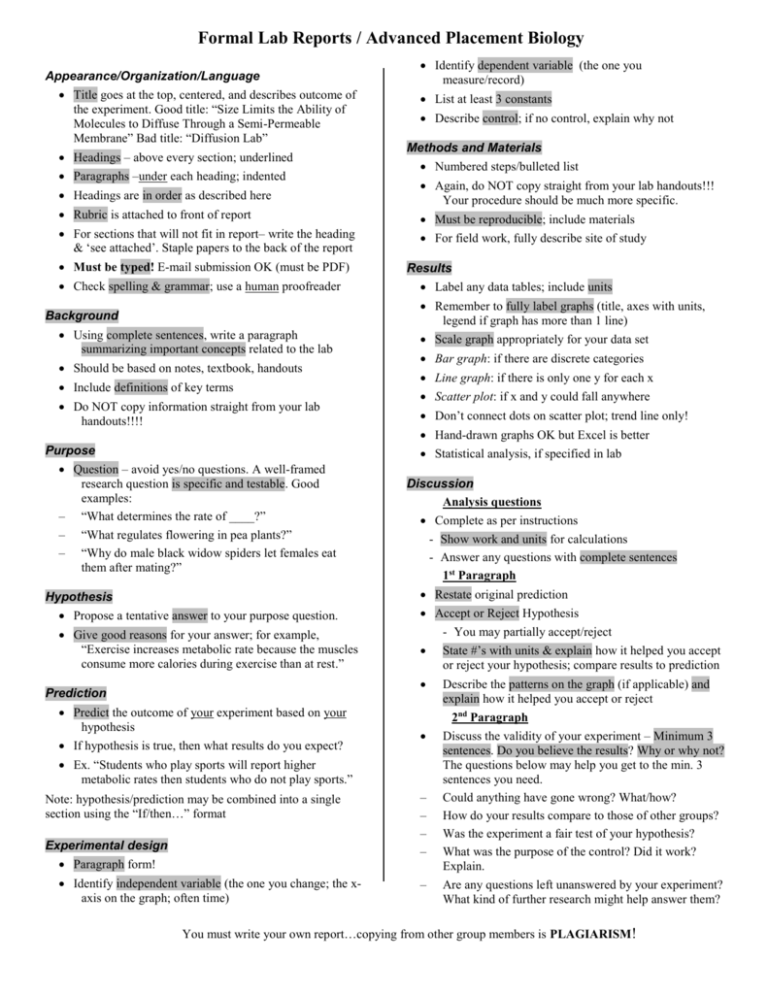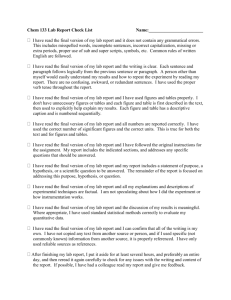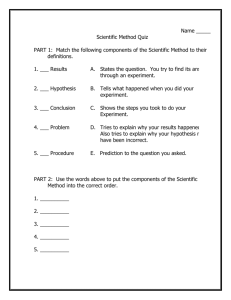Formal Lab Report Format
advertisement

Formal Lab Reports / Advanced Placement Biology Appearance/Organization/Language Title goes at the top, centered, and describes outcome of the experiment. Good title: “Size Limits the Ability of Molecules to Diffuse Through a Semi-Permeable Membrane” Bad title: “Diffusion Lab” Headings – above every section; underlined Paragraphs –under each heading; indented Headings are in order as described here Rubric is attached to front of report For sections that will not fit in report– write the heading & ‘see attached’. Staple papers to the back of the report Must be typed! E-mail submission OK (must be PDF) Check spelling & grammar; use a human proofreader Background Using complete sentences, write a paragraph summarizing important concepts related to the lab Should be based on notes, textbook, handouts Include definitions of key terms Do NOT copy information straight from your lab handouts!!!! Purpose Question – avoid yes/no questions. A well-framed research question is specific and testable. Good examples: – “What determines the rate of ____?” – “What regulates flowering in pea plants?” – “Why do male black widow spiders let females eat them after mating?” Identify dependent variable (the one you measure/record) List at least 3 constants Describe control; if no control, explain why not Methods and Materials Numbered steps/bulleted list Again, do NOT copy straight from your lab handouts!!! Your procedure should be much more specific. Must be reproducible; include materials For field work, fully describe site of study Results Label any data tables; include units Remember to fully label graphs (title, axes with units, legend if graph has more than 1 line) Scale graph appropriately for your data set Bar graph: if there are discrete categories Line graph: if there is only one y for each x Scatter plot: if x and y could fall anywhere Don’t connect dots on scatter plot; trend line only! Hand-drawn graphs OK but Excel is better Statistical analysis, if specified in lab Discussion Analysis questions Complete as per instructions - Show work and units for calculations - Answer any questions with complete sentences 1st Paragraph Restate original prediction Hypothesis Propose a tentative answer to your purpose question. Give good reasons for your answer; for example, “Exercise increases metabolic rate because the muscles consume more calories during exercise than at rest.” Prediction Predict the outcome of your experiment based on your hypothesis If hypothesis is true, then what results do you expect? Accept or Reject Hypothesis - You may partially accept/reject State #’s with units & explain how it helped you accept or reject your hypothesis; compare results to prediction Describe the patterns on the graph (if applicable) and explain how it helped you accept or reject 2nd Paragraph Discuss the validity of your experiment – Minimum 3 sentences. Do you believe the results? Why or why not? The questions below may help you get to the min. 3 sentences you need. Could anything have gone wrong? What/how? How do your results compare to those of other groups? Was the experiment a fair test of your hypothesis? What was the purpose of the control? Did it work? Explain. Are any questions left unanswered by your experiment? What kind of further research might help answer them? Ex. “Students who play sports will report higher metabolic rates then students who do not play sports.” Note: hypothesis/prediction may be combined into a single section using the “If/then…” format Experimental design Paragraph form! Identify independent variable (the one you change; the xaxis on the graph; often time) – – – – – You must write your own report…copying from other group members is PLAGIARISM!









